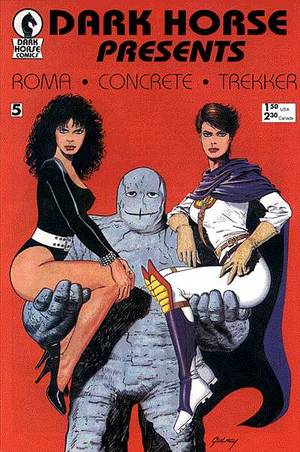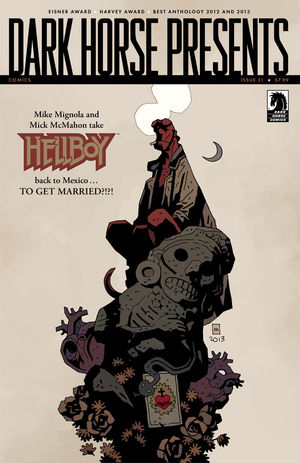It’s hard to believe (and I mean really hard to believe), but 2016 marks the thirtieth anniversary of our very first comic book. Way back in the summer of 1986, Dark Horse, which actually was composed of just Randy Stradley and yours truly, released its initial publication. Dark Horse Presents #1 consisted of Paul Chadwick’s Concrete, Chris Warner’s Black Cross, and Randy Stradley and Randy Emberlin’s Mindwalk. I’ve told the story many times of how we pasted that first issue up on the counter of my Beaverton, Oregon, comic book shop, hoping to reach the seemingly impossible break-even number of 10,000 copies sold. Well, we blew past that goal, selling out of the first print run of 50,000 copies and going on to a second printing.
The real story of Dark Horse’s origin goes back a bit further. I opened the doors of my first comic shop on January 1, 1980, in Bend, Oregon. The store was all of four hundred square feet and featured new comics, back issues, science-fiction paperbacks, posters, Dungeons & Dragons dice, and a few comics-related toys and collectibles. Sounds like a well-stocked shop, right? Well, not really. The depth of my merchandise was basically restricted by my funding source . . . a credit card my wife had managed to acquire with a $2,500 limit. The shop was small and its offerings limited by the budget. No matter—the joy of operating it could be found in the fact that every day was better than the previous day, every week saw sales climb above those of the week before, and every month set a new sales record. During that time I learned that there were many people with the same interests I had, and they didn’t all fit the profile some might have expected. Yes, a good portion of my regulars were high-school and college kids, but there were also doctors, lawyers, and accountants. In fact, my clientele featured people of all ages from all walks of life. Maybe not so surprising now, but back then that broader element of fandom was pretty much hidden from view.
My customers were constantly requesting that I bring the writers and artists who created the comics they read to the shop, something I began doing with regularity. At the end of each signing, I’d take the visiting creative talent out for a meal, and the same topic would come up repeatedly: the frustration they felt due to their inability to own the characters they created. Listening to this complaint got me thinking . . . What if there was a comics company that allowed creators to retain the rights to their work? It seemed like a pretty good idea.
The idea continued to grow in my mind. Five years later I gathered a group of nonprofessional artists and writers I had met through a sort of fanzine called APA-5. I explained to them that I was going to start publishing comics, and I also offered them 100 percent of the profits of the first publication. Roughly one year later Dark Horse Presents #1 hit the stands, and a new comics company was up and running.
Over these thirty years, our little company has grown up, and I’ve had the pleasure to meet many talented and amazing people, industry giants as well as those looking to break in. I’ve made lasting relationships and watched Dark Horse itself build a stable (excuse the pun) of the best and brightest within its own walls. It’s been a blast. The funny thing is that I still think of us as the “new guys.” Despite the passage of time, my goal is the same as it has always been—to make great comics—and my hope, as crazy as it sounds, is that I’m around for another thirty years to do just that.
Best,
Mike Richardson
It’s hard to believe (and I mean really hard to believe), but 2016 marks the thirtieth anniversary of our very first comic book. Way back in the summer of 1986, Dark Horse, which actually was composed of just Randy Stradley and yours truly, released its initial publication. Dark Horse Presents #1 consisted of Paul Chadwick’s Concrete, Chris Warner’s Black Cross, and Randy Stradley and Randy Emberlin’s Mindwalk. I’ve told the story many times of how we pasted that first issue up on the counter of my Beaverton, Oregon, comic book shop, hoping to reach the seemingly impossible break-even number of 10,000 copies sold. Well, we blew past that goal, selling out of the first print run of 50,000 copies and going on to a second printing.
The real story of Dark Horse’s origin goes back a bit further. I opened the doors of my first comic shop on January 1, 1980, in Bend, Oregon. The store was all of four hundred square feet and featured new comics, back issues, science-fiction paperbacks, posters, Dungeons & Dragons dice, and a few comics-related toys and collectibles. Sounds like a well-stocked shop, right? Well, not really. The depth of my merchandise was basically restricted by my funding source . . . a credit card my wife had managed to acquire with a $2,500 limit. The shop was small and its offerings limited by the budget. No matter—the joy of operating it could be found in the fact that every day was better than the previous day, every week saw sales climb above those of the week before, and every month set a new sales record. During that time I learned that there were many people with the same interests I had, and they didn’t all fit the profile some might have expected. Yes, a good portion of my regulars were high-school and college kids, but there were also doctors, lawyers, and accountants. In fact, my clientele featured people of all ages from all walks of life. Maybe not so surprising now, but back then that broader element of fandom was pretty much hidden from view.
My customers were constantly requesting that I bring the writers and artists who created the comics they read to the shop, something I began doing with regularity. At the end of each signing, I’d take the visiting creative talent out for a meal, and the same topic would come up repeatedly: the frustration they felt due to their inability to own the characters they created. Listening to this complaint got me thinking . . . What if there was a comics company that allowed creators to retain the rights to their work? It seemed like a pretty good idea.
The idea continued to grow in my mind. Five years later I gathered a group of nonprofessional artists and writers I had met through a sort of fanzine called APA-5. I explained to them that I was going to start publishing comics, and I also offered them 100 percent of the profits of the first publication. Roughly one year later Dark Horse Presents #1 hit the stands, and a new comics company was up and running.
Over these thirty years, our little company has grown up, and I’ve had the pleasure to meet many talented and amazing people, industry giants as well as those looking to break in. I’ve made lasting relationships and watched Dark Horse itself build a stable (excuse the pun) of the best and brightest within its own walls. It’s been a blast. The funny thing is that I still think of us as the “new guys.” Despite the passage of time, my goal is the same as it has always been—to make great comics—and my hope, as crazy as it sounds, is that I’m around for another thirty years to do just that.
Best,
Mike Richardson







